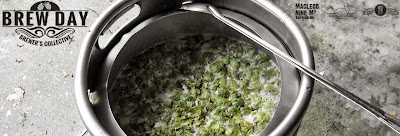 To start you want to ferment a batch of beer (preferably a sessionable low gravity pale beer) and be ready to rack into secondary/bottling or wherever. The night before you will have to boil several quart jars and 2 pint jars per quart jar as well as their lids to sterilize the jars lids and to deoxygenate the water that you will store in the jars (this helps the yeast take a long nap for storing). You want to cool this down overnight either in the refrigerator or in a cool spot. Just make sure that it is at room temperature for the next step so you don't shock the yeast with big temperature differences.
To start you want to ferment a batch of beer (preferably a sessionable low gravity pale beer) and be ready to rack into secondary/bottling or wherever. The night before you will have to boil several quart jars and 2 pint jars per quart jar as well as their lids to sterilize the jars lids and to deoxygenate the water that you will store in the jars (this helps the yeast take a long nap for storing). You want to cool this down overnight either in the refrigerator or in a cool spot. Just make sure that it is at room temperature for the next step so you don't shock the yeast with big temperature differences.Next you want to rack your beer as normal leaving as much of the trub behind. Then pitch in the room temperature water from the quart jars into the fermenter and swirl the fermenter to resuspend the trub. Allow this to settle for ~10-20 minutes. You should be able to see several layers at this point if you can see inside your fermenter i.e. a clear carboy. The viable yeast will be suspended and the proteins, hop gunk, dead yeast etc. will have fallen to the bottom. You will try to either rack off this top layer (resuspended yeast) or carefully pour off back into the quart jars. Cap them and allow to sit for a further ~10-20 minutes.
 At this point you should see another layer of stratification, again the top liquid is the desirable yeast and the trub at the bottom will be discarded. In the picture to the left it is mostly yeast with little trub, but it is there.
At this point you should see another layer of stratification, again the top liquid is the desirable yeast and the trub at the bottom will be discarded. In the picture to the left it is mostly yeast with little trub, but it is there.From here you can discard the water in the pint jars and and carefully pour the (hopefully large) top layer into the pint jars (1 quart jar fills 2 pint jars). You want to cap these jars fairly tightly and put in the refrigerator in a spot where they won't get too disturbed or fluctuate temperature. The cold deoxygenated water will help the yeast sleep.
When the yeast is stored in the fridge they should fall down to the bottom (see below) reminiscent to White Labs vials.
They can be stored for a long time, allegedly up to a year, but most professional sources say not to store this way more than a couple of weeks. I personally have had no problems up to about 6 weeks and the yeast from these pictures have been stored about 5 weeks already and I expect no problems. It is recommended though that when pitching yeast saved this way to pour off much of the "beer" above the yeast and use the slurry at the bottom to create a yeast starter. This, hopefully, will compensate for any lost viability due to storage. For further reading and more pictures you can visit the Homebrewtalk forum here that discusses the topic great detail.



May have to give this a try here in Korea. Not too sure how readily available brewer's yeast is going to be.
ReplyDelete